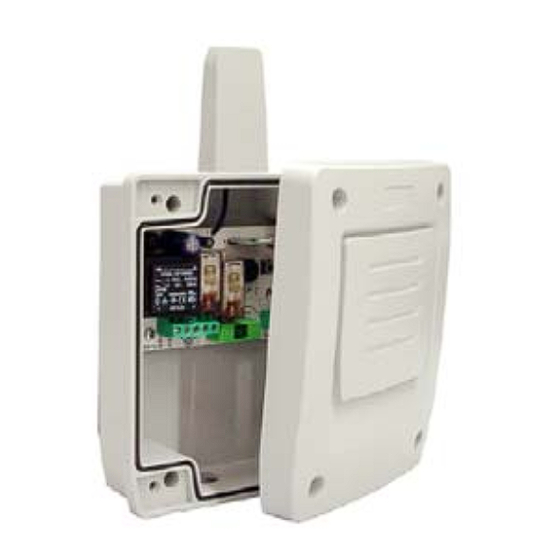
Table of Contents
Advertisement
Quick Links
1248015-GB_v1.1
Control panel with built-in receiver for axis centre motors and operators for roller doors and
shutters. It enables the memorising of 15 radio transmitters using the programming button.
CHARACTERISTICS
Receiver characteristics
Frequency
Coding
Memory
Panel characteristics
Supply
Maximum motor power
Standyby/Op. consumption
Motor fuse
Inputs
Photocell power supply output
Handling time
Op. temperature
Watertightness
Box dimensions
CONNECTIONS
1
Power supply 230V ac
2
Power supply 230V ac
3
Common motor
4
Motor (N)
5
Motor (N)
6
Photocell power supply output 12Vac
7
Photocell power supply output 12Vac
8
Common buttons
9
Safety edge resistive contact 8k2 (until 2 in parallel)
10
Start button (NA)
ROLLER 868
868,35MHz
High safety changing code
15 codes
230V AC ± 10% / 115Vac ±10%
0,75CV
23mA / 42mA (without photocells)
6A
Start and safety edges
12Vac (máx 130mA)
1 second - 2 minutes (45 seconds by default)
-20ºC to +85ºC
IP54 (with IP65 packing seal)
140x220x55mm
1 2 3 4 5
1
6 7 8 9 10
Advertisement
Table of Contents

Summary of Contents for JCM ROLLER 868
- Page 1 1248015-GB_v1.1 ROLLER 868 Control panel with built-in receiver for axis centre motors and operators for roller doors and shutters. It enables the memorising of 15 radio transmitters using the programming button. CHARACTERISTICS Receiver characteristics Frequency 868,35MHz Coding High safety changing code...
-
Page 2: Installation
1248015-GB_v1.1 ROLLER 868 INSTALLATION Fit the rear of the box to the wall using the raw plugs and screws supplied. Pass the cables through the bottom of the equipment. Connect the power supply cables to the terminals on the printed circuit, following the indications engraved on the board. Fit the front of the equipment to the rear using the screws supplied. - Page 3 1248015-GB_v1.1 ROLLER 868 Possible connections: A1) Connection of two safety edge in parallel (open and close): This acts on opening and closing, causing stoppage and 1 second inversion. The connection of a start button is optional. J1 in OFF. (1) - Safety edge in opening...
- Page 4 1248015-GB_v1.1 ROLLER 868 A security device (photocells, normally closed contact) can be connected in series with the safety edge. The activation of this security device causes a stoppage and a total reversion of the door. A3) Connection without safety edges: The connection of a start button is optional. Situate the jumper J1 on 2B position.
-
Page 5: Time Programming
1248015-GB_v1.1 ROLLER 868 B2) Semi-automatic operating in opening and dead man operating in closing: Optionally two pushbuttons could be connected. One on the ALT terminal that will operate as an opening/stop button in opening, and the other on the BSEG terminal that will operate as a dead man button in closing. -
Page 6: Receiver Operations
1248015-GB_v1.1 ROLLER 868 The first time ALT/START is pressed, the door opens and begins to memorise the handling time. The second time it is pressed, it stops, ends to memorise the handling time and begins to temporise the waiting time for autoclosing. The third time it is pressed, ends to temporise waiting time for autoclosing, closes and programming is exited (the red pilot light goes out). - Page 7 1248015-GB_v1.1 ROLLER 868 CODE CANCELLATION TOTAL RESET In programming mode, the programming button is held down for over 10 sec. The equipment will issue 10 short acoustic warning signals followed by others at a faster pace to indicate that the operation has been successful. The equipment is now in programming mode. The pilot programming light will also follow the acoustic indications by flashing.
-
Page 8: Ce Declaration Of Conformity
Do not use the door if repair work or adjustments are required, as this may cause damage. Hereby, JCM TECHNOLOGIES, S.A., declares that this ROLLER 868 is in compliance with the essential requirements and other relevant provisions of Directive 1999/5/EC.

Need help?
Do you have a question about the ROLLER 868 and is the answer not in the manual?
Questions and answers